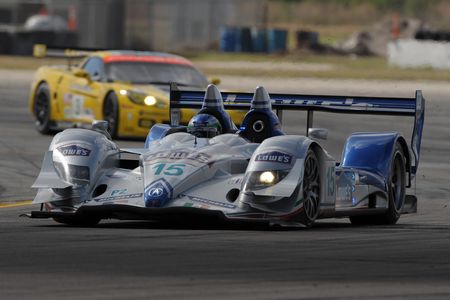Pandamasque wrote:PS: is Wirth still involved in the Acura programme?
Wirth Research was commissioned to conceive a new LMP for 2011, but it's not known if by Acura. Acura will have an evolution of the LMP2 car (the ARX-01c) on the track in 2010 (including in Le Mans, if their application is accepted), but no news link this development to Wirth Research, the original authors of the Courage conversion.
ESPImperium wrote:I relly like where you have came from on that one. Cars that have came from the windtunnel, and have been said to be fast in recent years, well havnt. Take the Renault R27, Honda RA107 & RA108, McLaren have had the same problem for the MP4/21 i belive, and lets face it Toyota came out with too much relyance from the tunnel with their TF106 and TF107.
Well, I don't know your sources, but I believe CFD and wintunnel testing have been used hand-in-hand by every F1 team since they've got their hands on the tool (surely since the beginning of the century). In the
thread I've mentioned before, there's an excellent post on it:
xxChrisxx wrote:It has NOTHING to do with the people nor their abilities as engineers. Not being able to get an accurate answer first time it is an inherent flaw in SIMULATION. I find it highly annoying that you are bashing these people for being crap, when you simply don't know what is involved with simulation.
I will give you a
very brief intro to CFD simulation. The stuff below doesn't een come close to accurately describing the complexity of the modelling.
Refining a mathematical model (this is NOT the shape of the car but the equations modelling the physics of the flow) is an iterative process. A good guess to he right flow physics, say choosing the right flow model will get you 90% to a decent solution. To get more accurate required very detailed and very boring tedious work, analysing model outputs and comparing them to computer code.
We have several models for flow already, they all basically do the same thing, which is solve Navier-Stokes equation numerically (as a non-linear pde it can't be solved y conventional techniques:

The fact that its a numerical solution used, mean that it's impossible to get a correct answer, you can just get answers of increasing accuracy. This is done for the amount of cells you have in your CFD and it can track the changes to pressure/velocity of the fluid.
HOWEVER! The solution doesnt invovle plugging ang chuggin this, becuase it would try to solve the equation for, basically every molecule of air. Which is computationally almost impossilbe on current systesm.
As such very smalls flows are 'guesstimated at' by turbulence models, taken from the Reynolds averaged version of the N-S equation (RANS). There are lots of tubulence models. On the package i've used.
S-A
http://www.cfd-online.com/Wiki/Spalart-Allmaras_model
K-e
http://www.cfd-online.com/Wiki/K-epsilon_models
K-o
http://www.cfd-online.com/Wiki/K-omega_models
http://www.cfd-online.com/Wiki/RANS-bas ... nce_models
These basically involve putting in constants, to describe the turbulence. The engineer does not know these constants becuase they change for every flow. So all the data in the world will not give you the correct constants, they have to be found by trial and error.
This is done by comparing model output to something that has more fidelity to reality. In this case a windtunnel. Windtunnels are incredibly accurate if set up and the flow measured correctly. This can be then fine tune the model to gie correct results.
Now do you see, why removing the thing to compare the model against doesn't work. You can't fine tune it to get the correct answer. This is NOT the fault of the engineer/aero guy. Even if you didn't understand a word of this, please stop insulting the engineers who do this for a living.
Even though I understand that only wintunnel testing gives you a good, solid process to estimate the adequate constants to apply to the turbulent air models in the CFD simulation, while the Wirth Reseach guys will have to
guestimate them, I'm also sympathetic with marcush's view: in my point of view, if only wintunnel will give you the final tenths of a second, a poorly calibrated windtunnel may lead your constant estimations so wrong that you may be full seconds behind.
ESPImperium wrote:wesley123 wrote:really, Nick Wirth is completely naive, he does the same with the Acura LMP's and come on, those things arent good, the only reason they won LMP was because they were the only ones, when Peugeot and Audi were contesting too they were nowhere near, so that already is a great example why he shouldnt do that.
After that article i have my doubts in Virgin already
Could turn out like the 1997 or 1998 Lola in other words???
Anyone remember the Lola T97/30??? 11-13 seconds off the pace and it literally had little testing and wind tunnel data.

Well, the Lola T97/30 never saw a wintunnel
nor a CFD station, since the little time available after MasterCard decided that the car had to race in 1997, rather than 1998, the initial plan.
Also, you seem to see Wirth as a novice, but he has already designed very interesting F1 chassis (the 1994 and 1995
Simteks), that weren't successful
more because of the lack of funding rather than because of poor design. I see no reason to think he lost his mind and is now completetly unaware of the risks is incurring because of this decision. Virgin's plan is to reach the head of the field
in two or three years, if they don't succeed, you'll be free to say
"I told you so!", in the meantime, let's give them some credit








